Research Report on Digital Workplace Transformation for ASDA: HND
VerifiedAdded on 2023/06/07
|36
|4258
|66
Report
AI Summary
This research report, based on a study of ASDA, investigates the benefits of digital workplace transformation in enhancing organizational productivity and performance. The report includes a detailed literature review exploring the conceptual framework of digital workplace transformation, the requirements for digital transformation within an organization, and the potential challenges of its absence. The research methodology section outlines the research type, philosophy, approach, strategy, data collection methods, sampling techniques, and ethical considerations. The data analysis section presents findings from a survey of ASDA managers, analyzing frequencies and interpretations related to gender, age, awareness of digital workplace transition, and opinions on various aspects of digital transformation. The report concludes with recommendations and a summary of the findings, providing valuable insights for businesses seeking to leverage digital technologies for improved operational efficiency and competitive advantage. The report is a contribution by a student and is available on Desklib, a platform providing AI-based study tools for students.

PART 2: RESEARCH REPORT & SELF REFLECTION
1
1
Paraphrase This Document
Need a fresh take? Get an instant paraphrase of this document with our AI Paraphraser

TABLE OF CONTENTS
INTRODUCTION.......................................................................................................................................................................................4
Research aim............................................................................................................................................................................................4
Research objective...................................................................................................................................................................................4
Research question....................................................................................................................................................................................4
Rationale..................................................................................................................................................................................................4
LITERATURE REVIEW............................................................................................................................................................................5
Theme 1: To understand the conceptual framework related to digital workplace transformation..........................................................5
Theme 2: Analysing the requirements of DT within organization..........................................................................................................5
Theme 3: Potential challenges which the firm faced because of absence of digital workplace transformation.....................................6
RESEARCH METHODOLOGY................................................................................................................................................................6
Research type...........................................................................................................................................................................................6
Research philosophy................................................................................................................................................................................7
Research approach...................................................................................................................................................................................7
Research strategy.....................................................................................................................................................................................7
Data collection.........................................................................................................................................................................................7
Sampling..................................................................................................................................................................................................8
Data analysis............................................................................................................................................................................................8
Ethical considerations..............................................................................................................................................................................8
Research limitations.................................................................................................................................................................................8
DATA ANALYSIS.....................................................................................................................................................................................9
RECOMMENDATIONS...........................................................................................................................................................................27
2
INTRODUCTION.......................................................................................................................................................................................4
Research aim............................................................................................................................................................................................4
Research objective...................................................................................................................................................................................4
Research question....................................................................................................................................................................................4
Rationale..................................................................................................................................................................................................4
LITERATURE REVIEW............................................................................................................................................................................5
Theme 1: To understand the conceptual framework related to digital workplace transformation..........................................................5
Theme 2: Analysing the requirements of DT within organization..........................................................................................................5
Theme 3: Potential challenges which the firm faced because of absence of digital workplace transformation.....................................6
RESEARCH METHODOLOGY................................................................................................................................................................6
Research type...........................................................................................................................................................................................6
Research philosophy................................................................................................................................................................................7
Research approach...................................................................................................................................................................................7
Research strategy.....................................................................................................................................................................................7
Data collection.........................................................................................................................................................................................7
Sampling..................................................................................................................................................................................................8
Data analysis............................................................................................................................................................................................8
Ethical considerations..............................................................................................................................................................................8
Research limitations.................................................................................................................................................................................8
DATA ANALYSIS.....................................................................................................................................................................................9
RECOMMENDATIONS...........................................................................................................................................................................27
2

CONCLUSION..........................................................................................................................................................................................28
REFERENCES..........................................................................................................................................................................................29
APPENDIX................................................................................................................................................................................................30
3
REFERENCES..........................................................................................................................................................................................29
APPENDIX................................................................................................................................................................................................30
3
⊘ This is a preview!⊘
Do you want full access?
Subscribe today to unlock all pages.

Trusted by 1+ million students worldwide
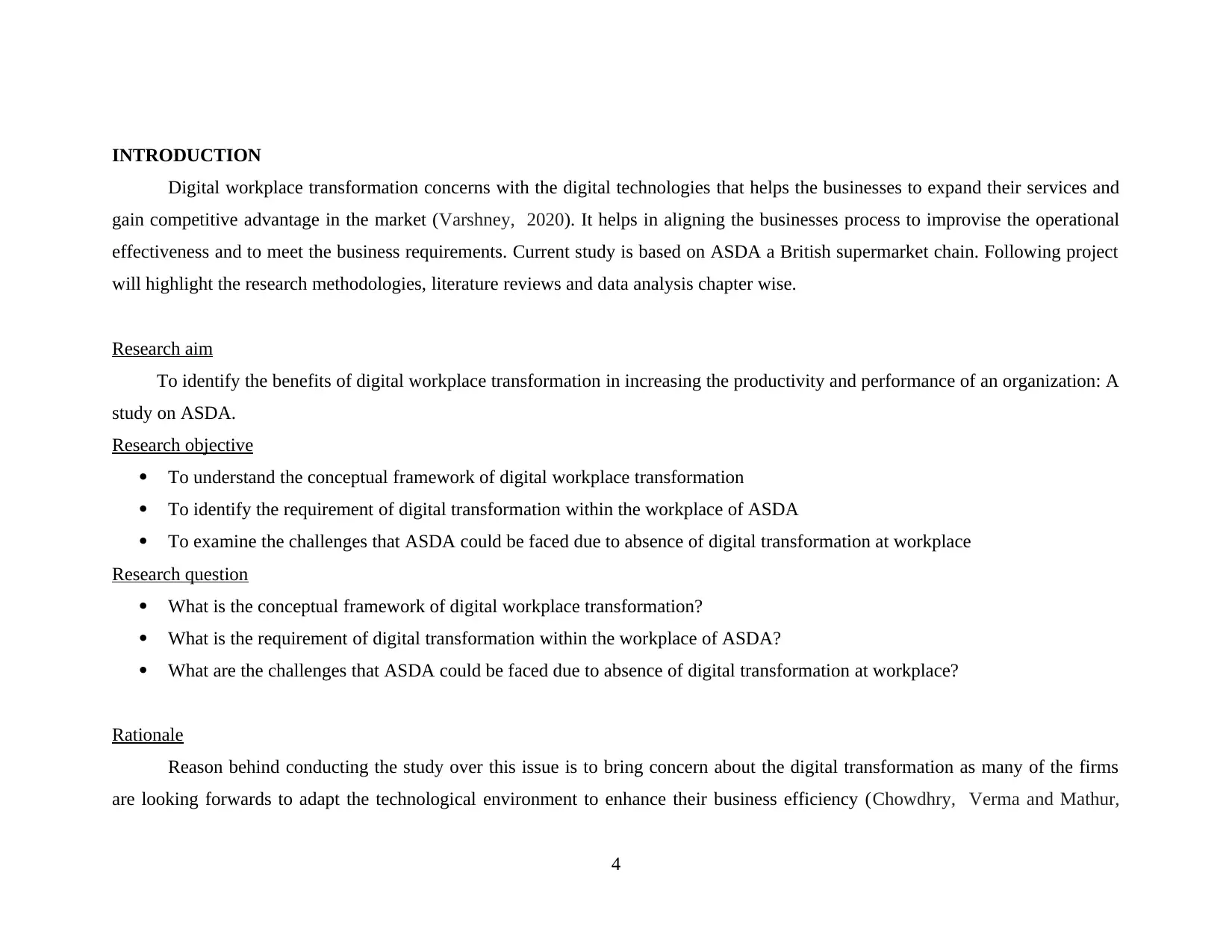
INTRODUCTION
Digital workplace transformation concerns with the digital technologies that helps the businesses to expand their services and
gain competitive advantage in the market (Varshney, 2020). It helps in aligning the businesses process to improvise the operational
effectiveness and to meet the business requirements. Current study is based on ASDA a British supermarket chain. Following project
will highlight the research methodologies, literature reviews and data analysis chapter wise.
Research aim
To identify the benefits of digital workplace transformation in increasing the productivity and performance of an organization: A
study on ASDA.
Research objective
To understand the conceptual framework of digital workplace transformation
To identify the requirement of digital transformation within the workplace of ASDA
To examine the challenges that ASDA could be faced due to absence of digital transformation at workplace
Research question
What is the conceptual framework of digital workplace transformation?
What is the requirement of digital transformation within the workplace of ASDA?
What are the challenges that ASDA could be faced due to absence of digital transformation at workplace?
Rationale
Reason behind conducting the study over this issue is to bring concern about the digital transformation as many of the firms
are looking forwards to adapt the technological environment to enhance their business efficiency (Chowdhry, Verma and Mathur,
4
Digital workplace transformation concerns with the digital technologies that helps the businesses to expand their services and
gain competitive advantage in the market (Varshney, 2020). It helps in aligning the businesses process to improvise the operational
effectiveness and to meet the business requirements. Current study is based on ASDA a British supermarket chain. Following project
will highlight the research methodologies, literature reviews and data analysis chapter wise.
Research aim
To identify the benefits of digital workplace transformation in increasing the productivity and performance of an organization: A
study on ASDA.
Research objective
To understand the conceptual framework of digital workplace transformation
To identify the requirement of digital transformation within the workplace of ASDA
To examine the challenges that ASDA could be faced due to absence of digital transformation at workplace
Research question
What is the conceptual framework of digital workplace transformation?
What is the requirement of digital transformation within the workplace of ASDA?
What are the challenges that ASDA could be faced due to absence of digital transformation at workplace?
Rationale
Reason behind conducting the study over this issue is to bring concern about the digital transformation as many of the firms
are looking forwards to adapt the technological environment to enhance their business efficiency (Chowdhry, Verma and Mathur,
4
Paraphrase This Document
Need a fresh take? Get an instant paraphrase of this document with our AI Paraphraser
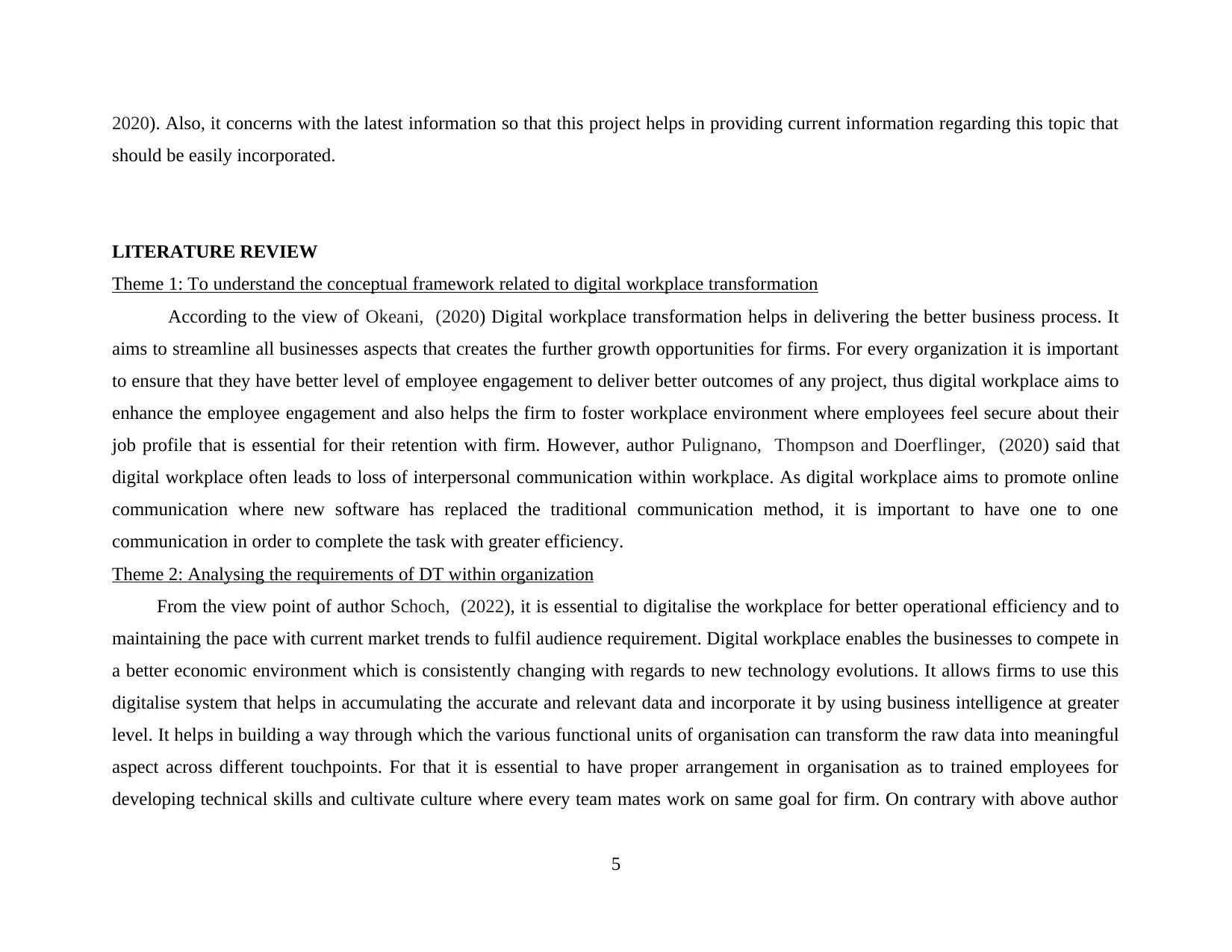
2020). Also, it concerns with the latest information so that this project helps in providing current information regarding this topic that
should be easily incorporated.
LITERATURE REVIEW
Theme 1: To understand the conceptual framework related to digital workplace transformation
According to the view of Okeani, (2020) Digital workplace transformation helps in delivering the better business process. It
aims to streamline all businesses aspects that creates the further growth opportunities for firms. For every organization it is important
to ensure that they have better level of employee engagement to deliver better outcomes of any project, thus digital workplace aims to
enhance the employee engagement and also helps the firm to foster workplace environment where employees feel secure about their
job profile that is essential for their retention with firm. However, author Pulignano, Thompson and Doerflinger, (2020) said that
digital workplace often leads to loss of interpersonal communication within workplace. As digital workplace aims to promote online
communication where new software has replaced the traditional communication method, it is important to have one to one
communication in order to complete the task with greater efficiency.
Theme 2: Analysing the requirements of DT within organization
From the view point of author Schoch, (2022), it is essential to digitalise the workplace for better operational efficiency and to
maintaining the pace with current market trends to fulfil audience requirement. Digital workplace enables the businesses to compete in
a better economic environment which is consistently changing with regards to new technology evolutions. It allows firms to use this
digitalise system that helps in accumulating the accurate and relevant data and incorporate it by using business intelligence at greater
level. It helps in building a way through which the various functional units of organisation can transform the raw data into meaningful
aspect across different touchpoints. For that it is essential to have proper arrangement in organisation as to trained employees for
developing technical skills and cultivate culture where every team mates work on same goal for firm. On contrary with above author
5
should be easily incorporated.
LITERATURE REVIEW
Theme 1: To understand the conceptual framework related to digital workplace transformation
According to the view of Okeani, (2020) Digital workplace transformation helps in delivering the better business process. It
aims to streamline all businesses aspects that creates the further growth opportunities for firms. For every organization it is important
to ensure that they have better level of employee engagement to deliver better outcomes of any project, thus digital workplace aims to
enhance the employee engagement and also helps the firm to foster workplace environment where employees feel secure about their
job profile that is essential for their retention with firm. However, author Pulignano, Thompson and Doerflinger, (2020) said that
digital workplace often leads to loss of interpersonal communication within workplace. As digital workplace aims to promote online
communication where new software has replaced the traditional communication method, it is important to have one to one
communication in order to complete the task with greater efficiency.
Theme 2: Analysing the requirements of DT within organization
From the view point of author Schoch, (2022), it is essential to digitalise the workplace for better operational efficiency and to
maintaining the pace with current market trends to fulfil audience requirement. Digital workplace enables the businesses to compete in
a better economic environment which is consistently changing with regards to new technology evolutions. It allows firms to use this
digitalise system that helps in accumulating the accurate and relevant data and incorporate it by using business intelligence at greater
level. It helps in building a way through which the various functional units of organisation can transform the raw data into meaningful
aspect across different touchpoints. For that it is essential to have proper arrangement in organisation as to trained employees for
developing technical skills and cultivate culture where every team mates work on same goal for firm. On contrary with above author
5
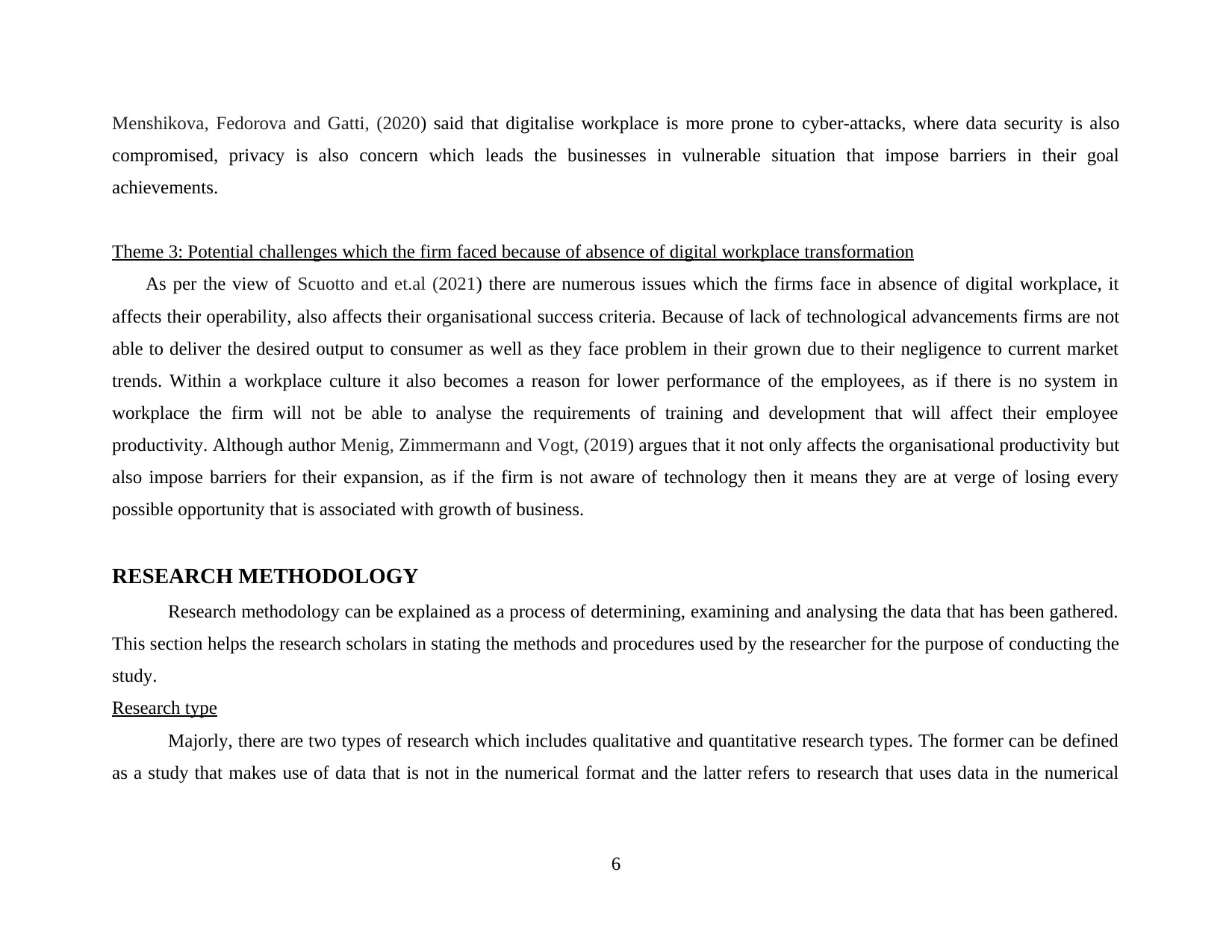
Menshikova, Fedorova and Gatti, (2020) said that digitalise workplace is more prone to cyber-attacks, where data security is also
compromised, privacy is also concern which leads the businesses in vulnerable situation that impose barriers in their goal
achievements.
Theme 3: Potential challenges which the firm faced because of absence of digital workplace transformation
As per the view of Scuotto and et.al (2021) there are numerous issues which the firms face in absence of digital workplace, it
affects their operability, also affects their organisational success criteria. Because of lack of technological advancements firms are not
able to deliver the desired output to consumer as well as they face problem in their grown due to their negligence to current market
trends. Within a workplace culture it also becomes a reason for lower performance of the employees, as if there is no system in
workplace the firm will not be able to analyse the requirements of training and development that will affect their employee
productivity. Although author Menig, Zimmermann and Vogt, (2019) argues that it not only affects the organisational productivity but
also impose barriers for their expansion, as if the firm is not aware of technology then it means they are at verge of losing every
possible opportunity that is associated with growth of business.
RESEARCH METHODOLOGY
Research methodology can be explained as a process of determining, examining and analysing the data that has been gathered.
This section helps the research scholars in stating the methods and procedures used by the researcher for the purpose of conducting the
study.
Research type
Majorly, there are two types of research which includes qualitative and quantitative research types. The former can be defined
as a study that makes use of data that is not in the numerical format and the latter refers to research that uses data in the numerical
6
compromised, privacy is also concern which leads the businesses in vulnerable situation that impose barriers in their goal
achievements.
Theme 3: Potential challenges which the firm faced because of absence of digital workplace transformation
As per the view of Scuotto and et.al (2021) there are numerous issues which the firms face in absence of digital workplace, it
affects their operability, also affects their organisational success criteria. Because of lack of technological advancements firms are not
able to deliver the desired output to consumer as well as they face problem in their grown due to their negligence to current market
trends. Within a workplace culture it also becomes a reason for lower performance of the employees, as if there is no system in
workplace the firm will not be able to analyse the requirements of training and development that will affect their employee
productivity. Although author Menig, Zimmermann and Vogt, (2019) argues that it not only affects the organisational productivity but
also impose barriers for their expansion, as if the firm is not aware of technology then it means they are at verge of losing every
possible opportunity that is associated with growth of business.
RESEARCH METHODOLOGY
Research methodology can be explained as a process of determining, examining and analysing the data that has been gathered.
This section helps the research scholars in stating the methods and procedures used by the researcher for the purpose of conducting the
study.
Research type
Majorly, there are two types of research which includes qualitative and quantitative research types. The former can be defined
as a study that makes use of data that is not in the numerical format and the latter refers to research that uses data in the numerical
6
⊘ This is a preview!⊘
Do you want full access?
Subscribe today to unlock all pages.

Trusted by 1+ million students worldwide

form (Cr, 2020). The present study is quantitative research that has helped research scholar in effectively gathering the numerical data
that is related to the study.
Research philosophy
The research philosophy can be bifurcated into two major heads, namely, interpretivism and positivism research philosophy.
The interpretivism philosophy is used in case of a qualitative research and the positivism philosophy is used when there is a
quantitative research going on (Shkarlet and et.al 2020). However, since the current study is based on the quantitative research, the
researcher has made use of a positivism research philosophy in order to carry out the study.
Research approach
The research approach can be referred to as the plans and procedures that has been used by the researcher for the purpose of
carrying out the research. The research approach can be divided into two types, i.e., inductive and deductive research approach. The
formed is used when there is qualitative research and in case of a quantitative study, the deductive approach is used. Subsequently, the
current study is quantitative research, the deductive research approach has been used.
Research strategy
There are various types of research strategies that helps a researcher in gathering the data relevant to the subject of the study
(Mohajan, 2018). The different types of research strategies include survey, literature review, case study, action research and many
more. However, the current research has made use of the survey strategy in order to gather the data in relation to the research. The
survey has helped the researcher in gathering the numerical data and use the same in order to form relevant and necessary observations
and conclusions.
Data collection
The methods which are used by a researcher for the purpose of gathering the data that is related to the study is known as the
data collection. The data collection can be divided into two types, namely, primary and secondary data collection. However, the
present study has made use of primary as well as the secondary research methods for the purpose data collection. A survey among the
7
that is related to the study.
Research philosophy
The research philosophy can be bifurcated into two major heads, namely, interpretivism and positivism research philosophy.
The interpretivism philosophy is used in case of a qualitative research and the positivism philosophy is used when there is a
quantitative research going on (Shkarlet and et.al 2020). However, since the current study is based on the quantitative research, the
researcher has made use of a positivism research philosophy in order to carry out the study.
Research approach
The research approach can be referred to as the plans and procedures that has been used by the researcher for the purpose of
carrying out the research. The research approach can be divided into two types, i.e., inductive and deductive research approach. The
formed is used when there is qualitative research and in case of a quantitative study, the deductive approach is used. Subsequently, the
current study is quantitative research, the deductive research approach has been used.
Research strategy
There are various types of research strategies that helps a researcher in gathering the data relevant to the subject of the study
(Mohajan, 2018). The different types of research strategies include survey, literature review, case study, action research and many
more. However, the current research has made use of the survey strategy in order to gather the data in relation to the research. The
survey has helped the researcher in gathering the numerical data and use the same in order to form relevant and necessary observations
and conclusions.
Data collection
The methods which are used by a researcher for the purpose of gathering the data that is related to the study is known as the
data collection. The data collection can be divided into two types, namely, primary and secondary data collection. However, the
present study has made use of primary as well as the secondary research methods for the purpose data collection. A survey among the
7
Paraphrase This Document
Need a fresh take? Get an instant paraphrase of this document with our AI Paraphraser
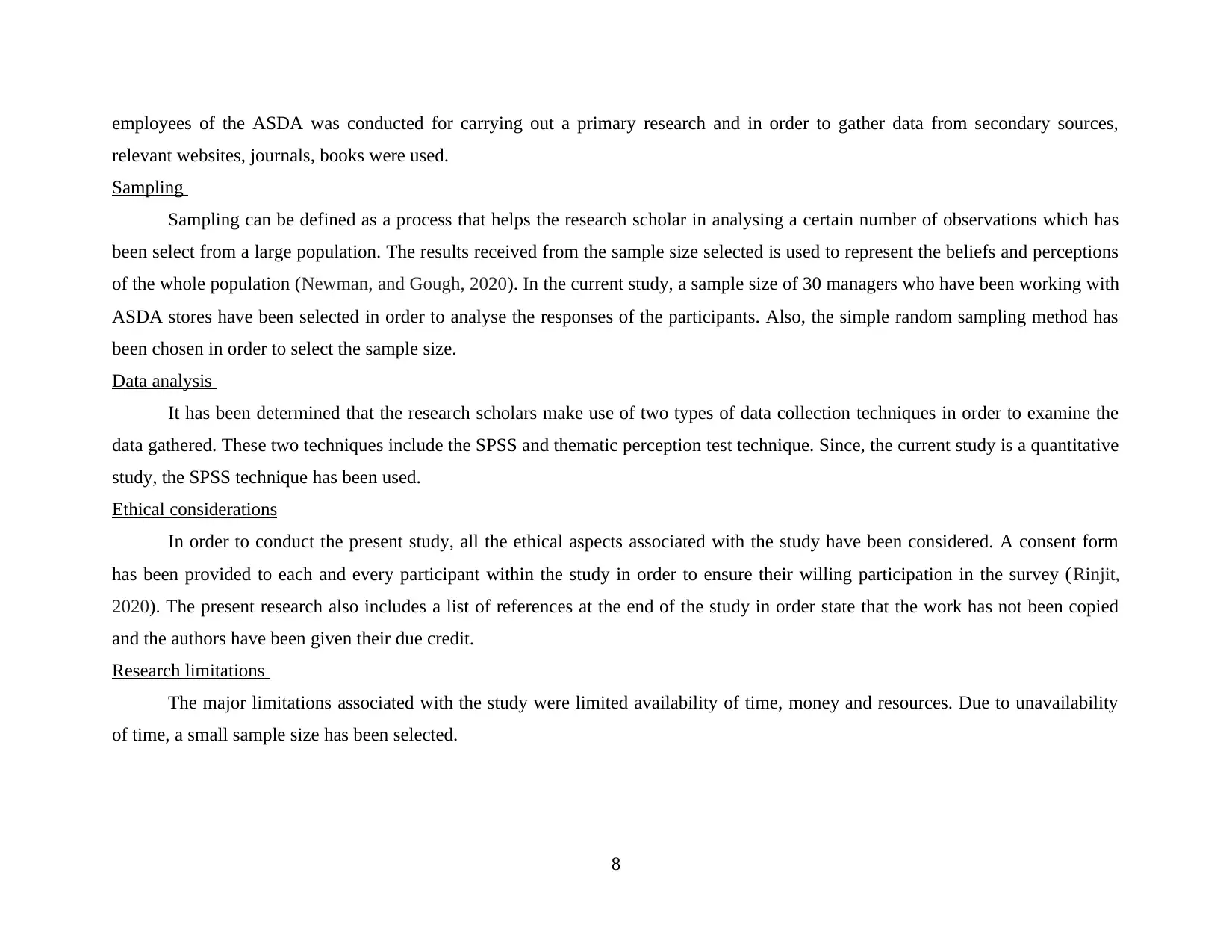
employees of the ASDA was conducted for carrying out a primary research and in order to gather data from secondary sources,
relevant websites, journals, books were used.
Sampling
Sampling can be defined as a process that helps the research scholar in analysing a certain number of observations which has
been select from a large population. The results received from the sample size selected is used to represent the beliefs and perceptions
of the whole population (Newman, and Gough, 2020). In the current study, a sample size of 30 managers who have been working with
ASDA stores have been selected in order to analyse the responses of the participants. Also, the simple random sampling method has
been chosen in order to select the sample size.
Data analysis
It has been determined that the research scholars make use of two types of data collection techniques in order to examine the
data gathered. These two techniques include the SPSS and thematic perception test technique. Since, the current study is a quantitative
study, the SPSS technique has been used.
Ethical considerations
In order to conduct the present study, all the ethical aspects associated with the study have been considered. A consent form
has been provided to each and every participant within the study in order to ensure their willing participation in the survey (Rinjit,
2020). The present research also includes a list of references at the end of the study in order state that the work has not been copied
and the authors have been given their due credit.
Research limitations
The major limitations associated with the study were limited availability of time, money and resources. Due to unavailability
of time, a small sample size has been selected.
8
relevant websites, journals, books were used.
Sampling
Sampling can be defined as a process that helps the research scholar in analysing a certain number of observations which has
been select from a large population. The results received from the sample size selected is used to represent the beliefs and perceptions
of the whole population (Newman, and Gough, 2020). In the current study, a sample size of 30 managers who have been working with
ASDA stores have been selected in order to analyse the responses of the participants. Also, the simple random sampling method has
been chosen in order to select the sample size.
Data analysis
It has been determined that the research scholars make use of two types of data collection techniques in order to examine the
data gathered. These two techniques include the SPSS and thematic perception test technique. Since, the current study is a quantitative
study, the SPSS technique has been used.
Ethical considerations
In order to conduct the present study, all the ethical aspects associated with the study have been considered. A consent form
has been provided to each and every participant within the study in order to ensure their willing participation in the survey (Rinjit,
2020). The present research also includes a list of references at the end of the study in order state that the work has not been copied
and the authors have been given their due credit.
Research limitations
The major limitations associated with the study were limited availability of time, money and resources. Due to unavailability
of time, a small sample size has been selected.
8

DATA ANALYSIS
Frequencies
Statistics
9
Frequencies
Statistics
9
⊘ This is a preview!⊘
Do you want full access?
Subscribe today to unlock all pages.

Trusted by 1+ million students worldwide
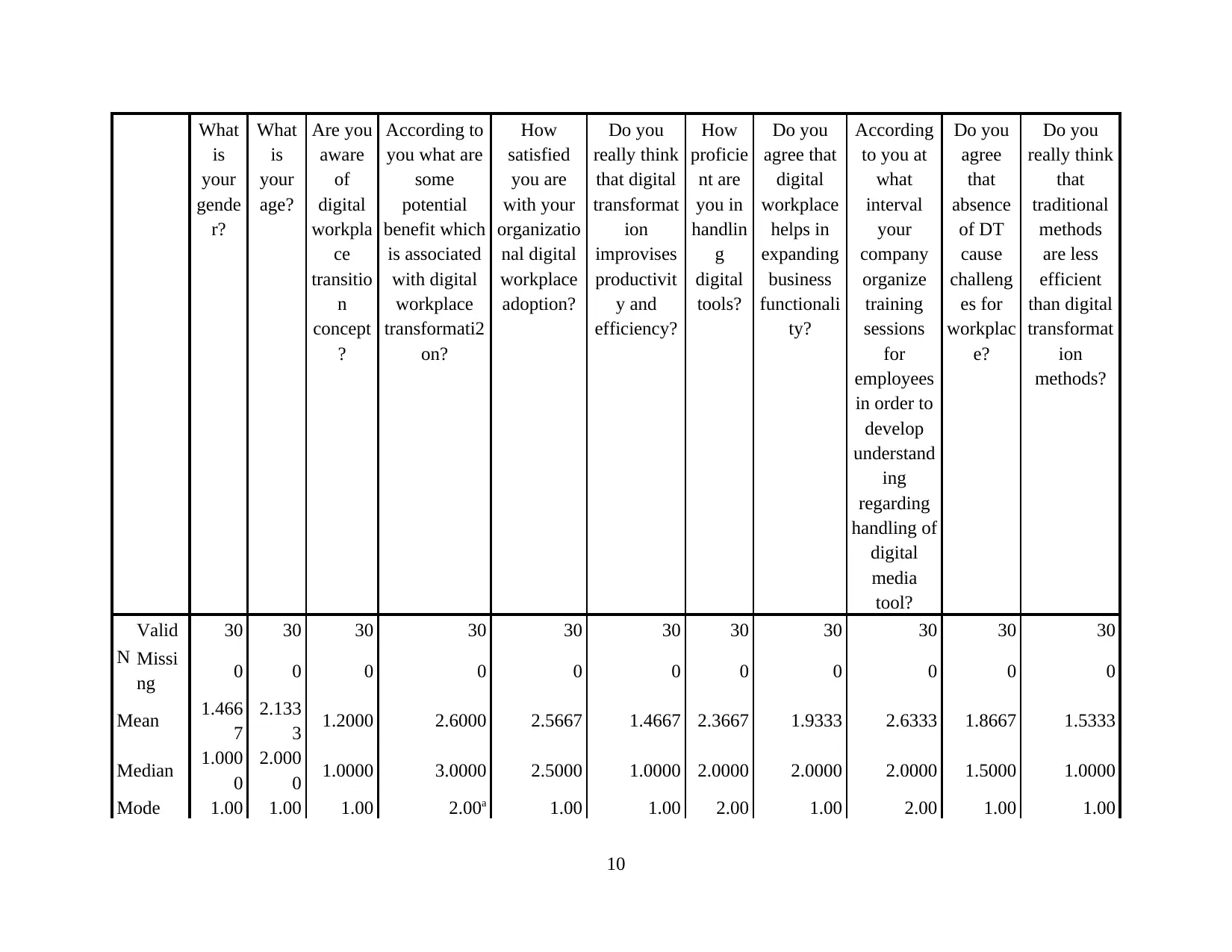
What
is
your
gende
r?
What
is
your
age?
Are you
aware
of
digital
workpla
ce
transitio
n
concept
?
According to
you what are
some
potential
benefit which
is associated
with digital
workplace
transformati2
on?
How
satisfied
you are
with your
organizatio
nal digital
workplace
adoption?
Do you
really think
that digital
transformat
ion
improvises
productivit
y and
efficiency?
How
proficie
nt are
you in
handlin
g
digital
tools?
Do you
agree that
digital
workplace
helps in
expanding
business
functionali
ty?
According
to you at
what
interval
your
company
organize
training
sessions
for
employees
in order to
develop
understand
ing
regarding
handling of
digital
media
tool?
Do you
agree
that
absence
of DT
cause
challeng
es for
workplac
e?
Do you
really think
that
traditional
methods
are less
efficient
than digital
transformat
ion
methods?
N
Valid 30 30 30 30 30 30 30 30 30 30 30
Missi
ng 0 0 0 0 0 0 0 0 0 0 0
Mean 1.466
7
2.133
3 1.2000 2.6000 2.5667 1.4667 2.3667 1.9333 2.6333 1.8667 1.5333
Median 1.000
0
2.000
0 1.0000 3.0000 2.5000 1.0000 2.0000 2.0000 2.0000 1.5000 1.0000
Mode 1.00 1.00 1.00 2.00a 1.00 1.00 2.00 1.00 2.00 1.00 1.00
10
is
your
gende
r?
What
is
your
age?
Are you
aware
of
digital
workpla
ce
transitio
n
concept
?
According to
you what are
some
potential
benefit which
is associated
with digital
workplace
transformati2
on?
How
satisfied
you are
with your
organizatio
nal digital
workplace
adoption?
Do you
really think
that digital
transformat
ion
improvises
productivit
y and
efficiency?
How
proficie
nt are
you in
handlin
g
digital
tools?
Do you
agree that
digital
workplace
helps in
expanding
business
functionali
ty?
According
to you at
what
interval
your
company
organize
training
sessions
for
employees
in order to
develop
understand
ing
regarding
handling of
digital
media
tool?
Do you
agree
that
absence
of DT
cause
challeng
es for
workplac
e?
Do you
really think
that
traditional
methods
are less
efficient
than digital
transformat
ion
methods?
N
Valid 30 30 30 30 30 30 30 30 30 30 30
Missi
ng 0 0 0 0 0 0 0 0 0 0 0
Mean 1.466
7
2.133
3 1.2000 2.6000 2.5667 1.4667 2.3667 1.9333 2.6333 1.8667 1.5333
Median 1.000
0
2.000
0 1.0000 3.0000 2.5000 1.0000 2.0000 2.0000 2.0000 1.5000 1.0000
Mode 1.00 1.00 1.00 2.00a 1.00 1.00 2.00 1.00 2.00 1.00 1.00
10
Paraphrase This Document
Need a fresh take? Get an instant paraphrase of this document with our AI Paraphraser
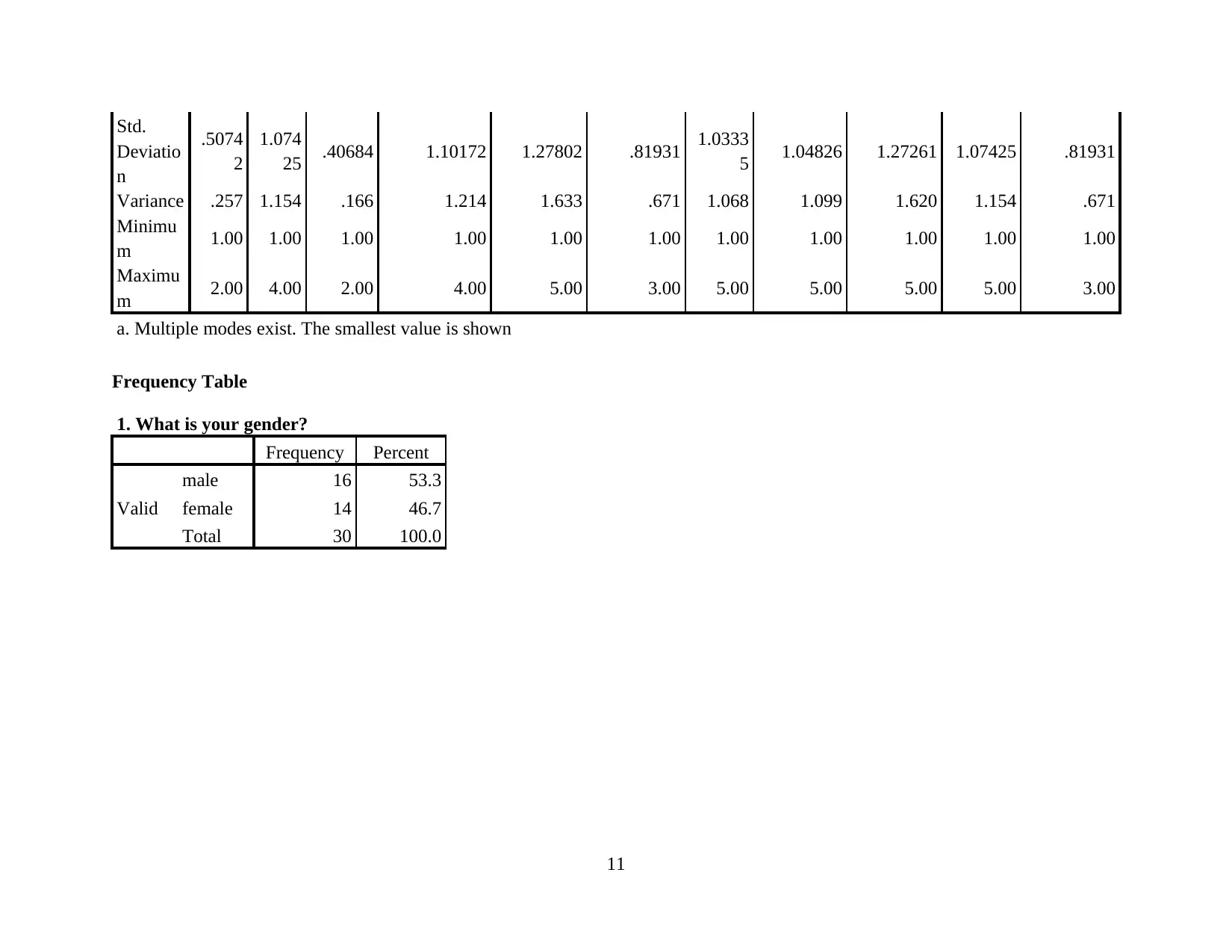
Std.
Deviatio
n
.5074
2
1.074
25 .40684 1.10172 1.27802 .81931 1.0333
5 1.04826 1.27261 1.07425 .81931
Variance .257 1.154 .166 1.214 1.633 .671 1.068 1.099 1.620 1.154 .671
Minimu
m 1.00 1.00 1.00 1.00 1.00 1.00 1.00 1.00 1.00 1.00 1.00
Maximu
m 2.00 4.00 2.00 4.00 5.00 3.00 5.00 5.00 5.00 5.00 3.00
a. Multiple modes exist. The smallest value is shown
Frequency Table
1. What is your gender?
Frequency Percent
Valid
male 16 53.3
female 14 46.7
Total 30 100.0
11
Deviatio
n
.5074
2
1.074
25 .40684 1.10172 1.27802 .81931 1.0333
5 1.04826 1.27261 1.07425 .81931
Variance .257 1.154 .166 1.214 1.633 .671 1.068 1.099 1.620 1.154 .671
Minimu
m 1.00 1.00 1.00 1.00 1.00 1.00 1.00 1.00 1.00 1.00 1.00
Maximu
m 2.00 4.00 2.00 4.00 5.00 3.00 5.00 5.00 5.00 5.00 3.00
a. Multiple modes exist. The smallest value is shown
Frequency Table
1. What is your gender?
Frequency Percent
Valid
male 16 53.3
female 14 46.7
Total 30 100.0
11
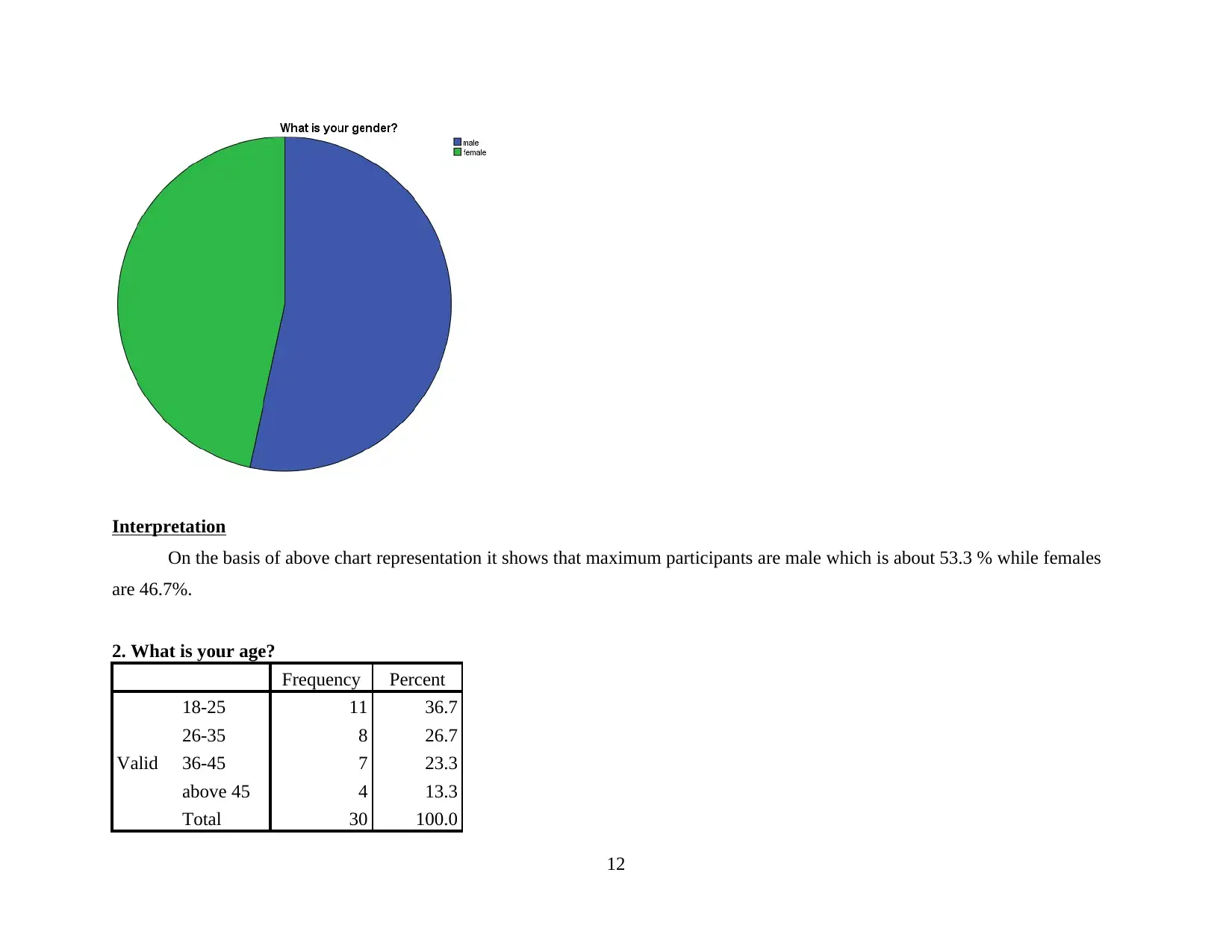
Interpretation
On the basis of above chart representation it shows that maximum participants are male which is about 53.3 % while females
are 46.7%.
2. What is your age?
Frequency Percent
Valid
18-25 11 36.7
26-35 8 26.7
36-45 7 23.3
above 45 4 13.3
Total 30 100.0
12
On the basis of above chart representation it shows that maximum participants are male which is about 53.3 % while females
are 46.7%.
2. What is your age?
Frequency Percent
Valid
18-25 11 36.7
26-35 8 26.7
36-45 7 23.3
above 45 4 13.3
Total 30 100.0
12
⊘ This is a preview!⊘
Do you want full access?
Subscribe today to unlock all pages.

Trusted by 1+ million students worldwide
1 out of 36
Related Documents
Your All-in-One AI-Powered Toolkit for Academic Success.
+13062052269
info@desklib.com
Available 24*7 on WhatsApp / Email
![[object Object]](/_next/static/media/star-bottom.7253800d.svg)
Unlock your academic potential
Copyright © 2020–2025 A2Z Services. All Rights Reserved. Developed and managed by ZUCOL.





